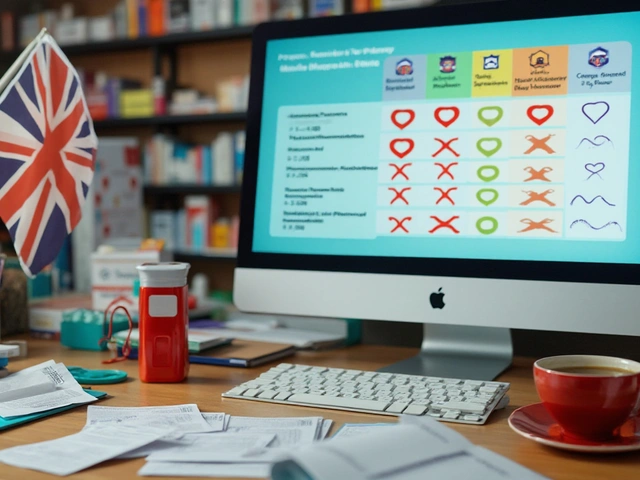Did you know that more than 30million Americans fill a Celebrex prescription every year, yet many never learn about cheaper or safer options? If you’re scrolling through pharmacy aisles or hunting online, you probably wonder whether Celebrex is the best pick for your joint pain, or if another NSAID could give you the same relief with fewer downsides.
What is Celebrex (celecoxib) really?
Celecoxib is a selective COX‑2 inhibitor approved to treat osteoarthritis, rheumatoid arthritis, ankylosing spondylitis, and acute pain from surgery. By blocking only the COX‑2 enzyme, it aims to spare the stomach‑lining COX‑1 enzyme that causes ulcers with traditional NSAIDs. The usual dose for arthritis is 100-200mg once daily; for acute pain, doctors may prescribe 400mg initially, then 200mg twice daily.
Its benefits are clear: strong anti‑inflammatory action, once‑daily dosing, and a lower risk of stomach bleeding compared with non‑selective NSAIDs. However, Celebrex carries a black‑box warning for increased cardiovascular (CV) events, especially at higher doses or in patients with existing heart disease.
Common alternatives to Celebrex
When doctors talk about “NSAIDs,” they’re usually referring to a family of drugs that share similar mechanisms but differ in selectivity, potency, and side‑effect profiles. Below are the most widely used alternatives:
- Ibuprofen - a non‑selective NSAID sold over‑the‑counter, typical dose 200‑800mg every 6‑8hours.
- Naproxen - a longer‑acting non‑selective NSAID, usually 250‑500mg twice daily.
- Diclofenac - available as tablets, gel, or patch; often 50‑150mg daily split into two doses.
- Meloxicam - a semi‑selective COX‑2 inhibitor, 7.5‑15mg once daily.
- Etoricoxib - another selective COX‑2 blocker, 30‑90mg once daily (not FDA‑approved in the U.S., but common in Europe).
Other non‑drug strategies-like physiotherapy, weight loss, or topical capsaicin-can complement or replace oral meds, but the focus here is on prescription‑level alternatives that a doctor might suggest.
How do they stack up? Comparison table
| Drug | Mechanism | Typical Dose | GI Ulcer Risk | Cardiovascular Risk | Average Monthly Cost (USD) |
|---|---|---|---|---|---|
| Celecoxib | Selective COX‑2 | 100‑200mg once daily | Low | Moderate‑High (dose‑dependent) | $45‑$70 |
| Ibuprofen | Non‑selective COX‑1/2 | 200‑800mg q6‑8h | Moderate | Low‑Moderate | $10‑$20 (OTC) |
| Naproxen | Non‑selective COX‑1/2 | 250‑500mg BID | Moderate | Low | $12‑$25 (OTC) |
| Diclofenac | Non‑selective COX‑1/2 | 50‑150mg daily | High (especially oral) | High | $30‑$60 |
| Meloxicam | Partial COX‑2 | 7.5‑15mg once daily | Low‑Moderate | Moderate | $25‑$40 |
| Etoricoxib | Selective COX‑2 | 30‑90mg once daily | Low | High (especially >60mg) | $70‑$120 (outside US) |
The table makes a few things obvious. Celebrex and Etoricoxib share the low GI‑ulcer profile of COX‑2 selectivity, but both carry a higher cardiovascular warning. Ibuprofen and Naproxen are cheaper and have a lower CV risk, yet they can irritate the stomach, especially if taken without food.

When is Celebrex the right choice?
If you have a history of stomach ulcers or chronic gastritis, a selective COX‑2 blocker often feels safer. Celebrex’s once‑daily regimen also helps people who struggle with multiple daily pills. It’s especially popular for chronic conditions like osteoarthritis where long‑term adherence matters.
However, you should steer clear of Celebrex if you’ve had a heart attack, stroke, or uncontrolled hypertension unless your cardiologist explicitly says it’s okay. In those cases, a lower‑CV‑risk NSAID like Naproxen or even non‑pharmacologic measures might be wiser.
When should you consider an alternative?
Here are common scenarios that push patients toward other drugs:
- Budget constraints: Over‑the‑counter options (Ibuprofen, Naproxen) can cost under $15 a month, dramatically less than Celebrex’s $60‑plus price tag.
- Cardiovascular concerns: If you have atrial fibrillation, recent stent placement, or are on anticoagulants, Naproxen’s relatively benign CV profile often makes it the safer bet.
- Need for stronger anti‑inflammatory punch: Diclofenac and high‑dose Ibuprofen can sometimes out‑perform Celebrex for acute flare‑ups, but they come with higher GI risk.
- Allergy or intolerance: Some patients react to the sulfonamide group in Celecoxib; switching to a non‑sulfa NSAID like Naproxen avoids that issue.
In each case, the decision hinges on weighing efficacy against side‑effects, cost, and personal health history.
How to talk to your doctor about switching
Never stop or swap a prescription on your own. Bring these points to the appointment:
- List any current heart or stomach problems you have.
- Share a recent medication list, especially blood thinners, steroids, or other NSAIDs.
- Ask about the specific risk level for the drug they’re prescribing.
- Request a trial period for a lower‑cost alternative and a clear plan for monitoring pain control.
- Discuss non‑drug options (physical therapy, weight loss, supplements) that could let you taper the dose.
Doctors appreciate patients who come prepared; it makes the risk‑benefit conversation smoother.
Quick checklist: Choosing the right NSAID for you
- Stomach health: Prior ulcers → pick a COX‑2 selective (Celecoxib, Etoricoxib, Meloxicam).
- Heart health: Prior CV event → avoid COX‑2 selective; consider Naproxen or low‑dose Ibuprofen.
- Cost: Tight budget → OTC NSAIDs (Ibuprofen, Naproxen).
- Dosage convenience: Want once‑daily → Celecoxib or Meloxicam.
- Allergy to sulfa: Skip Celecoxib, use Naproxen or Ibuprofen.
Cross‑checking these items against your own medical history will narrow the field before you even step into the clinic.
Frequently Asked Questions
Can I take Celebrex with aspirin?
Mixing Celebrex with low‑dose aspirin (often used for heart protection) can increase bleeding risk, even though Celebrex itself spares the stomach. Talk to your doctor; they may adjust the aspirin dose or switch you to a different NSAID.
Is Celebrex safe for long‑term use?
For most patients without heart disease, long‑term Celebrex is tolerated well, especially compared with non‑selective NSAIDs that cause ulcers. Still, doctors usually schedule periodic check‑ups to monitor blood pressure and heart health.
What’s the biggest advantage of ibuprofen over Celebrex?
Cost and cardiovascular safety. Ibuprofen is cheap, readily available, and carries a lower risk of heart attacks at typical over‑the‑counter doses.
Can I switch from Celebrex to naproxen without a wash‑out period?
Usually, yes. Both drugs are NSAIDs, so you can transition directly, but start naproxen at a low dose and watch for stomach upset. Your doctor may suggest a short protective proton‑pump inhibitor if you have a ulcer history.
Are there natural alternatives that match Celebrex’s pain relief?
Herbal anti‑inflammatories like turmeric or boswellia can help mild arthritis pain, but they rarely match the potency of a prescription NSAID. They’re best used alongside, not instead of, medical therapy.
Armed with this side‑by‑side view, you can have a focused conversation with your clinician about whether Celebrex or one of its Celebrex alternatives fits your lifestyle, budget, and health profile.








vijay sainath October 12, 2025
Man, if you’re still popping Celebrex without checking your wallet, you’re basically funding a pharmacy scam. Those pills may spare your stomach, but they’ll bleed your bank account dry and probably your heart too. Stop acting like you’re invincible and actually read the label.
Daisy canales October 22, 2025
Wow another pharma masterpiece, because we needed a pricey COX‑2 miracle. Sure, pay extra for the same pain relief, why not 🙄
keyul prajapati November 1, 2025
The decision between Celecoxib and its over‑the‑counter counterparts is rarely a matter of simply “cheap versus expensive.” It hinges on a constellation of individual risk factors that most patients overlook until a complication arises. For individuals with a documented history of peptic ulcer disease, the COX‑2 selectivity of Celecoxib does indeed provide a tangible gastro‑protective advantage. Conversely, patients with established cardiovascular disease must weigh the modestly elevated risk of myocardial infarction that accompanies higher doses of selective inhibitors. Age further complicates the calculus, as renal function declines and the pharmacokinetic profile of NSAIDs shifts. Moreover, the pharmacoeconomic impact cannot be dismissed; while the monthly cost of Celecoxib often exceeds fifty dollars, generic ibuprofen can be obtained for a fraction of that price. Insurance formularies sometimes mitigate the expense, yet copay requirements and prior‑authorization hurdles may erode any perceived savings. From a dosing convenience perspective, a once‑daily regimen may improve adherence for arthritic patients who struggle with multiple daily pills. However, adherence does not guarantee safety; regular monitoring of blood pressure and lipid panels remains advisable. The role of concomitant medications, such as low‑dose aspirin or anticoagulants, introduces additional layers of interaction risk. In clinical practice, I have observed that patients who switch abruptly from a non‑selective NSAID to Celecoxib without a wash‑out period sometimes experience a resurgence of inflammation. A gradual titration, coupled with gastro‑protective agents when indicated, often yields a smoother transition. In summary, the “best” NSAID is the one that aligns with the patient’s comorbid conditions, financial constraints, and lifestyle preferences. Engaging in an open dialogue with the prescribing physician is essential to tailor therapy appropriately. Ultimately, the therapeutic goal is to achieve sufficient analgesia while minimizing iatrogenic harm. Therefore, a nuanced risk‑benefit assessment should precede any wholesale adoption of Celecoxib as a first‑line agent.
Alice L November 11, 2025
Dear colleagues, the comparative analysis of cyclo‑oxygenase inhibitors presented herein offers a commendable synthesis of pharmacodynamic and socioeconomic considerations. It is imperative, however, to contextualize these data within the broader cultural paradigm of patient‑centred care, wherein therapeutic decisions reflect not only biochemical efficacy but also individual values and health literacy. I would encourage practitioners to incorporate shared decision‑making frameworks when navigating the nuanced trade‑offs delineated above.
Seth Angel Chi November 20, 2025
Honestly the table oversimplifies; real‑world outcomes depend on genetics not just dosage.
Danny Wakefield November 30, 2025
Listen, the pharma giants don’t want you to know that Celecoxib’s price hike coincided with a secret lobbying push to silence cheaper NSAIDs. It’s like they’re feeding us a sugar‑coated pill while siphoning our health data. Keep your eyes open, friend.
Samantha Dean December 10, 2025
From an epistemological standpoint, one must scrutinize the evidentiary basis upon which drug safety profiles are constructed. The literature suggests a spectrum of risk that is mediated by both intrinsic patient variables and extrinsic prescribing practices. Consequently, a dialectic approach to medication selection, balancing empirical data with individual circumspection, is warranted.